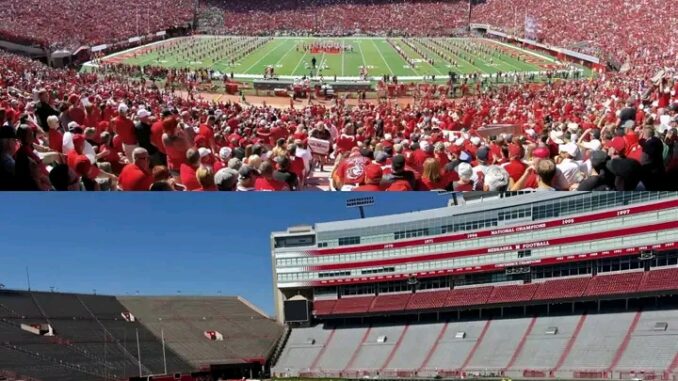
Project Overview
.
- South Stadium Reconstruction: .
- Seating Upgrades: .
- Concourse Connectivity: .
- Modern Amenities: .
- Accessibility Improvements: .
- Academic Integration: .
Financial Framework
- Private Contributions: .
- Athletic Department Funds: .
- University Internal Lending: .
.
Timeline and Impact
. .
. .
Enhancing the Fan Experience
- Student Engagement: .
- Premium Seating Options: .
- Improved Circulation: .
- Modern Concessions and Restrooms: .
Broader Vision
- Year-Round Utilization: .
- Community Engagement: .
Conclusion
—
The University of Nebraska-Lincoln is undertaking a transformative renovation of Memorial Stadium, aiming to modernize the century-old venue while preserving its storied legacy. With an estimated cost of $450 million, the project seeks to enhance the fan experience, improve accessibility, and ensure the stadium remains a premier destination for collegiate athletics.
—
Project Overview
Memorial Stadium, home to Nebraska Cornhuskers football since 1923, is set for a comprehensive overhaul. Athletic Director Trev Alberts emphasized the necessity of a holistic approach, stating, “We have one opportunity to do this, we’re gonna rethink everything about Memorial Stadium” . The renovation plans include:
South Stadium Reconstruction: Complete demolition and rebuilding to feature multi-tiered seating, enhanced student sections, and premium club areas .
Seating Upgrades: Installation of chair-back seating in the South, East, and West Stadiums to replace existing bench seating .
Concourse Connectivity: Creation of a 360-degree main-level concourse and a 270-degree upper-level concourse to facilitate better crowd movement .
Modern Amenities: Upgrades to concession areas with expanded menu options and increased points of sale, along with comprehensive restroom renovations .
Accessibility Improvements: Implementation of ADA upgrades throughout the stadium to ensure inclusivity for all fans .
Academic Integration: Inclusion of academic curriculum space, promoting year-round utilization of the facility beyond athletic events .
—
Financial Framework
The $450 million renovation will be funded through a combination of private donations and internal resources:
Private Contributions: Approximately $225 million is expected to come from private donors .
Athletic Department Funds: Around $100 million will be sourced from the athletic department’s reserves and generated revenues .
University Internal Lending: An additional $50 million is anticipated from the university’s internal lending program .
Importantly, the university has emphasized that no state tax dollars, student tuition, or general operating funds will be utilized for the renovation .
—
Timeline and Impact
Major construction is scheduled to begin in January 2025, with the South Stadium being unavailable for the 2025 season . The university aims to complete the renovations by August 2026, just before the start of the football season. However, Alberts has acknowledged potential challenges, including weather and supply chain issues, which could affect the timeline .
During the renovation, approximately 23,000 seats will be unavailable, and the stadium’s overall capacity will decrease by 10-12%, bringing it to the mid-70,000s . Alberts clarified that this reduction is aimed at enhancing comfort and accessibility, not increasing ticket prices .
—
Enhancing the Fan Experience
The renovation focuses on creating a more inclusive and engaging environment for all attendees:
Student Engagement: The new South Stadium will house the student section and the Cornhusker Marching Band, fostering a vibrant game-day atmosphere .
Premium Seating Options: Introduction of loge boxes and other premium seating to cater to diverse fan preferences .
Improved Circulation: Enhanced concourse connectivity will allow fans to navigate the stadium more easily .
Modern Concessions and Restrooms: Upgraded facilities will reduce wait times and improve overall convenience .
—
Broader Vision
Beyond football, the renovated Memorial Stadium is envisioned as a multi-purpose facility:
Year-Round Utilization: Plans include integrating academic spaces and hosting various events to maximize the stadium’s use .
Community Engagement: The stadium aims to serve as a hub for community activities, strengthening ties between the university and the public .
—
Conclusion
The Memorial Stadium renovation represents a significant investment in the future of Nebraska Athletics and the broader university community. By modernizing the facility, enhancing the fan experience, and expanding its utility, the university seeks to honor the stadium’s rich history while positioning it for continued relevance in the decades to come.
Leave a Reply